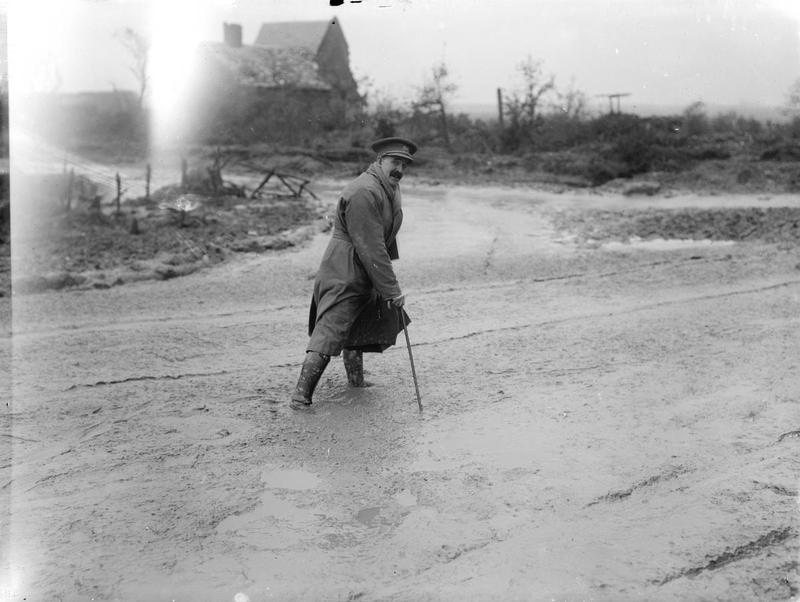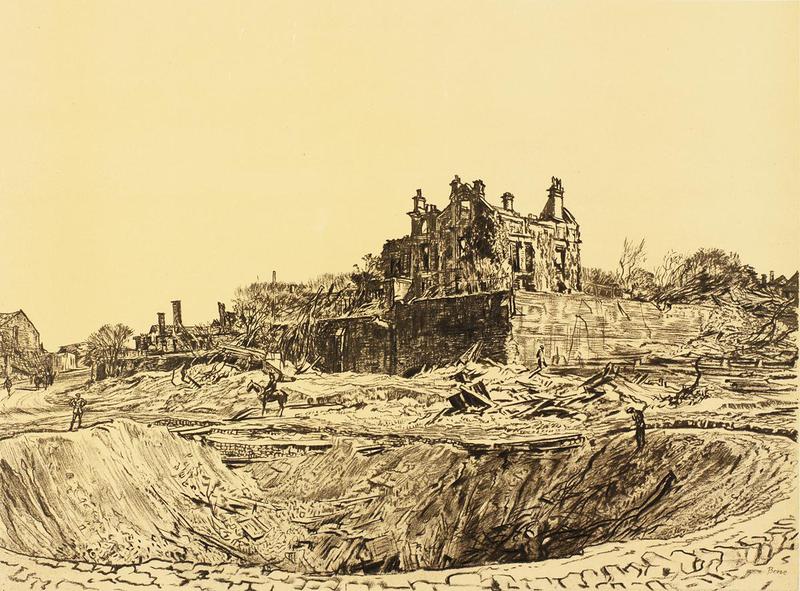Muirhead Bone was born on the 23rd March 1876 in the suburb of Partick in Glasgow. Born into rather an impoverished family, any talent Bone and his siblings showed was encouraged. Each birthday Bone received artist’s materials and every week he was sent out by his father to draw a scene. Bone became an apprentice to an architect at the age of fourteen; he pursued this whilst studying at the Glasgow School of Art in the evenings. In 1902 Bone settled in London and became a member of the New English Art Club. In 1908 and 1910, Bone became internationally renowned as his work was shown in France and Germany respectively.
In 1916 at a Red Cross sale of blank canvases, A.S. Watt, a literary agent who worked for the War Propaganda Bureau, Wellington House, bought a canvas to be worked on by Bone. When Bone contacted him to discuss the subject of the canvas, he informed him that it had better be settled on immediately as he was soon to be conscripted. Watt suggested to Wellington House, that they employ Bone as official war artist. This was a good idea as there was a serious drought of good art work in London and the public were becoming bored of photography with its ‘endless shots of soldiers going over the top or sitting in trenches’ (Cumming, 1978, p.468). It was also thought that his international reputation would help promote Britain’s cause overseas. Bone was sent to France in August 1916 to draw scenes of the Front, he was given a salary of £500 per annum and given the title and uniform of a second lieutenant.

He was employed to make drawings of ‘appropriate war scenes’ for propaganda and for historical record. He was the first official war artist. Bone proceeded to work for Wellington House and the Ministry of Munitions making pictures at the Front, of munitions works on the Home Front and of shipyards and the Fleet. He was extremely prolific and the continual demand for work soon exhausted him, prompting Mrs. Bone to write:
‘I watched him the other day looking at his pencil as though he didn’t know what to do with it...isn’t it possible for the Authorities to consider that 500 drawings in a year ought to be counted for an artist’s righteousness and to let him have space to draw breath?’ (Harries, 1983, pp.10-13)
The propaganda machine
Wellington House hired Bone, therefore, to a certain extent the images he created would have been made with a propagandist intention in mind. It could be claimed, therefore, that they told a biased version of a story, as some critics in the press at the time suggested. There is evidence to prove that there was a lot of government influence in Bone’s programme of employment and the pictures produced by Bone when he was employed by Wellington House (which were reproduced in a collection called The Western Front) were widely circulated. 12,000 copies of the publications were to be sold, 12,000 were to be used for propaganda and 6,000 were sent to America. The publication was also translated into French (Agence et Messageries du Figaro, 1916) and 300 of these editions were sent to France along with 500 in the original English. Plates and postcards were also reproduced for distribution. There is also evidence to prove, however, that what was represented in Bone’s sketches, etchings and lithographs was represented as truthfully as possible.
A realistic representation?
Art was decided upon as the instrument for illustrated propaganda because illustrative work of a high standard was needed in order to persuade the enemy that the image propaganda being produced had not been tampered with. It was believed that art work would be more believable than illustration and that to add to its validity, the art work had to be produced by known artists. The fact that art had been chosen for the primary reason of being believable means that Bone was chosen because he was considered to make realistic representations of scenes.
In addition to this desire to produce valid and believable propaganda through art, the programme was directed by a man who believed in the importance of facts. Charles Masterman ran the official war artists programme in the years 1916 and 1917, and he had an interesting opinion about his work at the propaganda bureau, he thought of it ‘with distaste’. Masterman took the opinion that the propaganda Bone was to create would have to tell the truth, he wanted Bone to represent facts and he wanted it to be real. He said, ‘ We have determined...to present facts and general arguments based upon those facts’ (Malvern, 2004, p.17). Masterman did not want the educated public to feel that Wellington House were trying to trick them into believing falsities, if they believed this, the organisation’s integrity would be reduced.
It is important to remember, however, that Bone was not sent off to France to draw whatever he wanted and return with images unexpected by Wellington House. Specifications were given and many letters written to the point of deciding what subjects Bone should target . This meant that, to an extent, what Bone’s pictures told was a ‘specific “truth”’, as opposed to the whole truth, because he was told exactly of which subjects to make representations. This is not to say that what Bone drew was not an actual representation of reality, just that the subject that he drew was carefully sanctioned by the government.
Bone’s artistry
Bone did use many artistic techniques and had a physical idiosyncrasy that would have been conducive to producing realistic representations of warfare. It was said that Bone’s eyesight, one of his eyes was short-sighted, the other was long-sighted, gave him a great ability to record in accurate detail the subject that he was viewing. Bone also had a technique that enabled him to draw anything anywhere, he would draw in a hand-held sketch book tearing out pages and attaching them to others using elastic bands so he could finish a drawing on the spot. This enabled Bone to capture an image exactly as it appeared before him, nothing needed to be added to the picture afterwards as he was able to record all details. This was unlike other war artists who, in producing great painted canvases, would have worked in a studio from notes, as Bone stated Nash did. His early training in architecture enabled him to perfectly capture the devastation wreaked on buildings during the war.

Another technique that Bone used to achieve completion of a sketch in one sitting was to use mediums that were suited to “on the spot” work such as pen, pencil, chalk, charcoal and watercolour. Bone trained himself to complete work in difficult conditions and all weathers, he was a person who had, ‘unflagging energy and endurance’ (Bone, 1966). This means he was well suited to war work and created works with striking realism.
Further Reading:
Bone Mary, Exhibition catalogue for Imperial War Museum exhibition celebrating 50th anniversary of Sir Muirhead Bone’s appointment as Official War Artist, (London, 1966)
Bone, Sylvester, Sir Muirhead Bone: Artist and Patron (London, 2009)
Cumming, Robert, ‘Recorder of a World at War, Sir Muirhead Bone (1876-1953)’, 23 February, 1978, Country Life.
Freeman Julian, British Art, A Walk Round the Rusty Pier, (London, 2006)
Harries, Merion and Susie, The War Artists, British Official War Art of the Twentieth Century, (London, 1983)
Malvern, Sue, Modern Art, Britain and the Great War, Witnessing, Testimony and Remembrance, (New Haven, 2004)
Malvern, Sue ‘ “War as it is”: The Art of Muirhead Bone, C.R.W. Nevinson and Paul Nash, 1916-1917’, Art History, 9:4, (December 1986), pp.487-515.
Malvern, Sue, ‘War Tourisms: “Englishness”, Art and the First World War, Oxford Art Journal, 24.1, (2001), pp.45-66.
Useful links to related material:
Keep tabs on the past.Sign up for our email alerts.